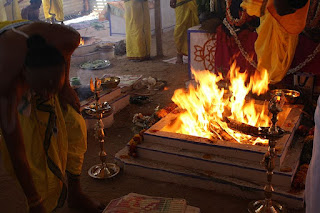Agni is the most sacred deity of the Vedic period. He occupies a prominent place only next to Indra. Two hundred hymns of the Rig-veda are devoted to him.
There are Vedic gods, whose names must have been framed before that
separation of the great Aryan family (the Hindus, the Persians, the
Greeks, the Romans, the Slave, the Celts, the Teutons: the seven branches of Aryan family ), and which occur therefore, through greatly modified in
character, sometimes in Greeks, sometimes in Latin, sometimes in Celtic,
Teutonic, and Slavonic dialects. For instances Fire is represented in
the Veda as a terrestrial deity: in Sanskrit Agni, in Latin ignis, ingle
Scottish, ugnis Lituanian. They had not as yet a name for God-certainly not in our sense of the word or even a general name for the gods; but they invented name after name to enable them to grasp and comprehend by some outward and visible tokens powers whose presence they felt in nature, though their true and full essence was to them, as it is to us, invisible and incomprehensible.
It came to mean not only fathers, but invisible, kind, powerful, immortal, heavenly beings, and we can watch in the Veda, better perhaps than anywhere else, the inevitable, yet most touching metamorphosis of ancient thought,- the love of the child for father and mother becoming transfigured into an instinctive belief in the immortality of the soul.*
#pictures showing people participating in 'Fire' worshiping rituals with Vedic mantras in Bhitthikala, Ambikapur, India; organized from 10th January 2013 to 13th January 2013.
# text reference thankfully shared from: India-What can it teach us by F. Max Muller, Oxford, 1882; The new vedic selection by KNS Telang and BB Chaubey, Prachya Bharati Prakashan, Varanasi, 1965.
* The lost child by Mulk Raj Anand.
(a reference: http://smohanraj.blogspot.in/2005/12/lost-child.html)















No comments:
Post a Comment